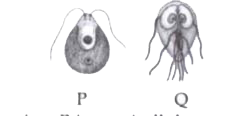Identify the given organisms (P-T) and select the incorrect statement regarding them.

(i) Organisms P, Q and T show tissue level of body organisation.
(ii) Organisms P, S and T are triploblastic animals.
(iii) Organisms R, S and T are eucoelomates.
(iv) Organisms P, R, S and T' possess notochord at some stage of their life.
(i) and (iii) only
(i), (ii) and (iv) only
(i) and (ii) only
(i), (ii) and (iii) only
The correct Answer is:B
In the given figures, organism P is Euplectella (Phylum Porifera), organism Q is Hydra (Phylum Coelenterata), organism Ris Palaemon, (Phylum Arthropoda), organism S is Octopus (Phylum Mollusca) and organism T is Asterias (Phylum Echinodermata). Organism P shows cellular level of body organisation, shows tissue level of body organisation whereas R, S and T show organ system level of body organisation. Organism Q shows diploblastic organisation while R, S and T show triploblastic organisation. Notochord is possessed by organisms of Phylum Chordata only.
Topper's Solved these Questions
Similar Questions
Knowledge Check
Study the given figures and select the correct statements regarding these.

(i) Organism P is a unicellular green alga.
(ii) Organism Q is a parasitic protozoan.
(iii) Organism Q causes diseases in human beings.
(iv) Both the organisms P and Q cannot synthesise their own food.A(i) and (ii) onlyB(ii), (iii) and (iv) onlyC(i), (ii) and (iii) onlyD(i), (ii), (iii) and (iv)Select incorrect statement w.r.t the following group of organisms and their characteristics
AChyrophyte - Includes diatoms and desmids, Planktonic organismBDinoflagellate - Mostly marine and photosynthetic, cell wall has stiff cellulosic plate on outer surfaceCEuglenoids - Majority of them are fresh water, cell wall is absentDSlime mould - Saprophytic motile spores with true wallsRefer to the given dichotomous key and select the incorrect option regarding organisms P, Q, R and S.
I. (a) Animals with cellular level of body organisation. - __P__
(b) Animals with tissue/organ/ organ system level of body organisation. - Go to II
II. (a)Animals possessing bilateral symmetry. - Go to III (a)
(b)Animals possessing radial symmetry.- Go to III (b)
III. (a) True coelom is present. - Go to IV (a)
True coelom is absent. - Go to IV (b)
IV. (a) Notochord is present. __Q__
(b) Notochord is absent. - Go to V
V. (a) It is represented by medusa form. ____R___
(b) It is represented by polyp form. - ___S___ABody of organism P could contain numerous small pores called ostia and a large opening called osculum on top.BOrganism Q could possess gill slits at some stage of its life.CThe body of organism Scould be differentiated into head, visceral mass and ventral foot.DOrganism R could possess nematocysts.
Refer to the given Venn diagram showing three organisms P, Q and R.

Which of the following statements hold true regarding P, Q and R?
(i) Chlamydomonas is shown as R.
(ii) Yeast is shown as Q.
(iii) Euglena is shown as P.
(iv) Organisms R and P form symbiotic association called lichen.
View SolutionRefer to the given passage and answer the following questions. P, Q and R are acoelomate organisms whereas S and T are true coelomates. P possesses cellular level of body organisation whereas others possess tissue and organ level of body organisation. Q possesses special stinging cells called cnidoblasts. R is the first triploblastic animal and has flame cells as excretory organs. The body of S is metamerically segmented whereas T bears jointed appendages and chitinous exoskeleton.
Which of the following is incorrect regarding organisms P, Q, R, S and T?
View SolutionRefer to the given dichotomous key. Identi fy P -T and select the incorrect statement.
I. (a) It is unicellular organism. - Go to II
(b) It is multicellular organism. Go to IV
II. (a) It possesses well organised nucleus. Go to III
(b) It lacks well organised nucleus. -P
III. (a) Nutrition is parasitic. -Q
(b) Nutrition is mixotrophic. -R
IV. (a) It possesses chlorophyll. - S
(b) It lacks chlorophyll. -T
View SolutionRefer to the given dichotomous key. Identi fy P -T and select the incorrect statement.
I. (a) It is unicellular organism. - Go to II
(b) It is multicellular organism. Go to IV
II. (a) It possesses well organised nucleus. Go to III
(b) It lacks well organised nucleus. -P
III. (a) Nutrition is parasitic. -Q
(b) Nutrition is mixotrophic. -R
IV. (a) It possesses chlorophyll. - S
(b) It lacks chlorophyll. -T
View SolutionP,Q,R,S and T are sitting around a circular table.R is to the right of P and is second to the left of S.T is not between P and S.Who is second to the left of R?
View Solution

